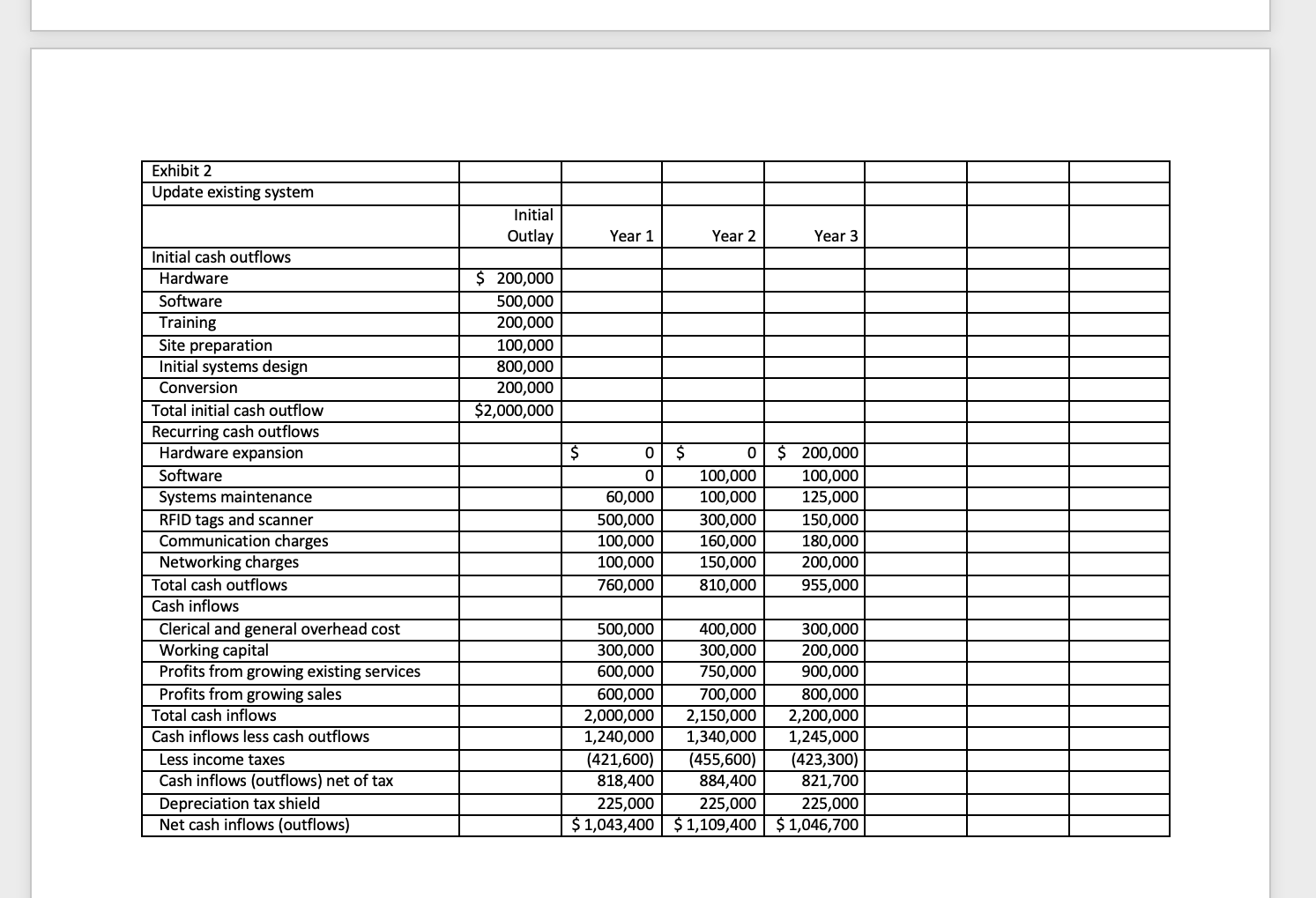The success of Maryville Environmental Services depends on Mike and Tims capital investment decision. They must decide either to: (1) install a new information technology system or (2) update the existing information technology system. Each alternative offers Maryville Environmental Services advantages and disadvantages in remaining a market leader in water engineering management. Only time will tell if Mike and Tim made the right decision. Such is the case for many difficult business decisions. You need to work with Mike and Tim and help them make the best decision possible at this time with the available data.
Exhibit 1 contains information related to estimated costs and savings associated with the purchase of a new information technology system.
Exhibit 2 contains information related to estimated costs and savings associated with the update of the existing information technology system.
- Compute the payback period for the two alternatives. Discuss the advantages and disadvantages of using the payback period to evaluate capital investment decisions. Based on the results of the calculated payback period, which investment would you recommend that Mike and Tim pursue?


Exhibit 1 Purchase new system Initial Outlay Year 1 Year 2 Year 3 Year 4 Year 5 Year 6 $ 1,750,000 1,050,000 200,000 250,000 2,000,000 750,000 $ 6,000,000 $ 0 0 Initial cash outflows Hardware Software Training Site preparation Initial systems design Conversion Total initial cash outflow Recurring cash outflows Hardware expansion Software Systems maintenance RFID tags and scanner Communication charges Networking charges Total cash outflows Cash inflows Clerical and general overhead cost Working capital Profits from growing existing services Profits from growing sales Total cash inflows Cash inflows less cash outflows Less income taxes Cash inflows (outflows) net of tax Depreciation tax shield Net cash inflows (outflows) 60,000 500,000 100,000 300,000 960,000 $ 40,000 $ 80,000 150,000 200,000 120,000 130,000 450,000 450,000 160,000 180,000 420,000 490,000 1,340,000 1,530,000 $ 120,000 $ 160,000 $ 200,000 225,000 250,000 275,000 140,000 150,000 160,000 400,000 200,000 100,000 200,000 220,000 240,000 560,000 630,000 700,000 1,645,000 1,610,000 1,675,000 60,000 100,000 0 0 160,000 (800,000) 272,000 (528,000) 297,500 (230,500) 600,000 300,000 900,000 700,000 2,500,000 1,160,000 (394,400) 765,600 297,500 1,063,100 700,000 500,000 900,000 800,000 2,900,000 1,370,000 (465,800) 904,200 297,500 1,201,700 800,000 1,000,000 1,200,000 1,200,000 4,200,000 2,555,000 (868,700) 1,686,300 297,500 1,983,800 900,000 800,000 1,400,000 1,600,000 4,700,000 3,090,000 (1,050,600) 2,039,400 297,500 2,336,900 1,000,000 800,000 1,500,000 2,000,000 5,300,000 3,625,000 (1,232,500) 2,392,500 297,500 2,690,000 Exhibit 2 Update existing system Initial Outlay Year 1 Year 2 Year 3 $ 200,000 500,000 200,000 100,000 800,000 200,000 $2,000,000 $ 0 $ 0 Initial cash outflows Hardware Software Training Site preparation Initial systems design Conversion Total initial cash outflow Recurring cash outflows Hardware expansion Software Systems maintenance RFID tags and scanner Communication charges Networking charges Total cash outflows Cash inflows Clerical and general overhead cost Working capital Profits from growing existing services Profits from growing sales Total cash inflows Cash inflows less cash outflows Less income taxes Cash inflows (outflows) net of tax Depreciation tax shield Net cash inflows (outflows) 60,000 500,000 100,000 100,000 760,000 0 100,000 100,000 300,000 160,000 150,000 810,000 $ 200,000 100,000 125,000 150,000 180,000 200,000 955,000 500,000 400,000 300,000 300,000 300,000 200,000 600,000 750,000 900,000 600,000 700,000 800,000 2,000,000 2,150,000 2,200,000 1,240,000 1,340,000 1,245,000 (421,600) (455,600) (423,300) 818,400 884,400 821,700 225,000 225,000 225,000 $ 1,043,400 $ 1,109,400 $ 1,046,700








